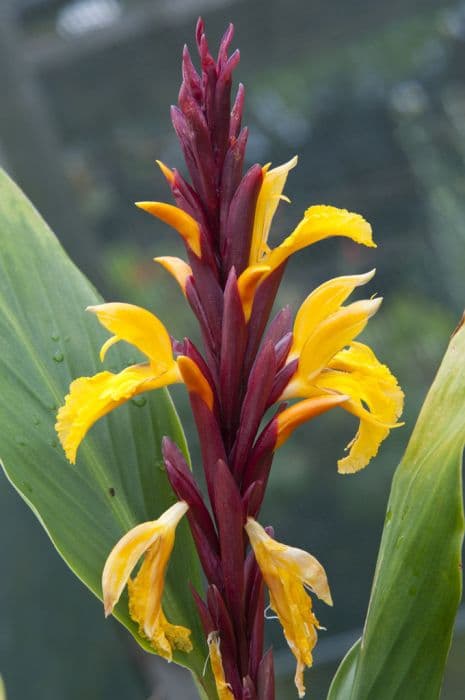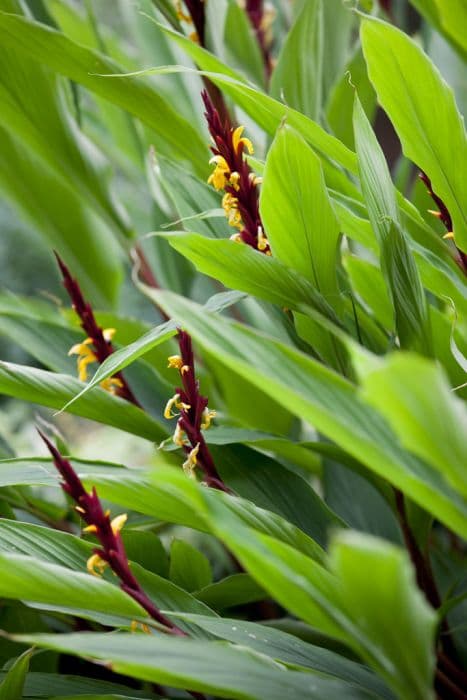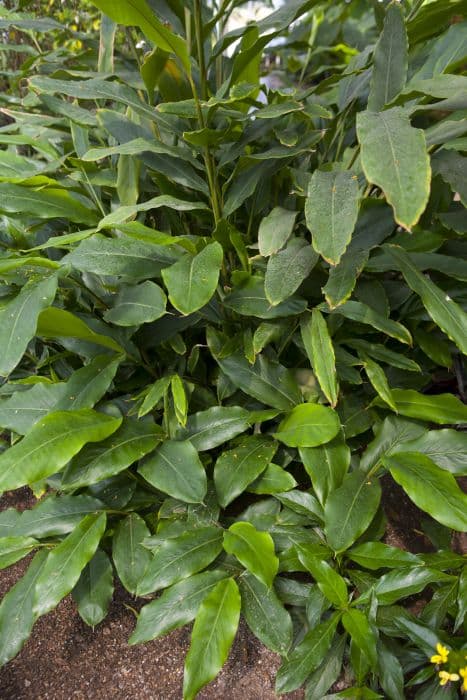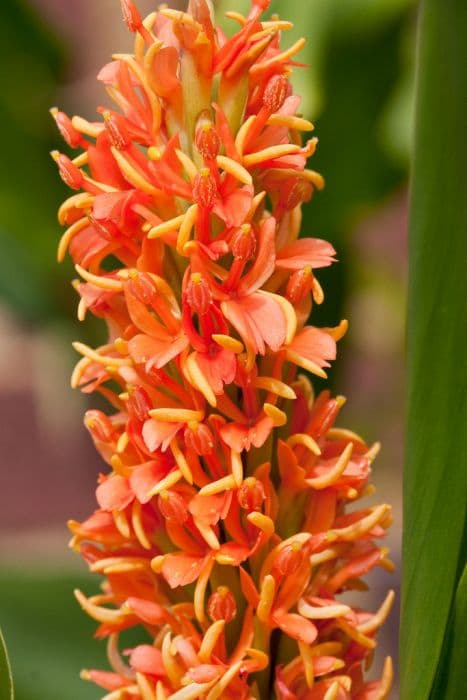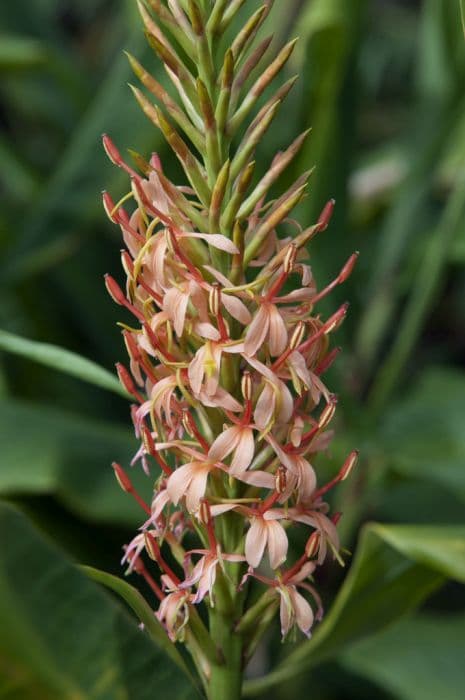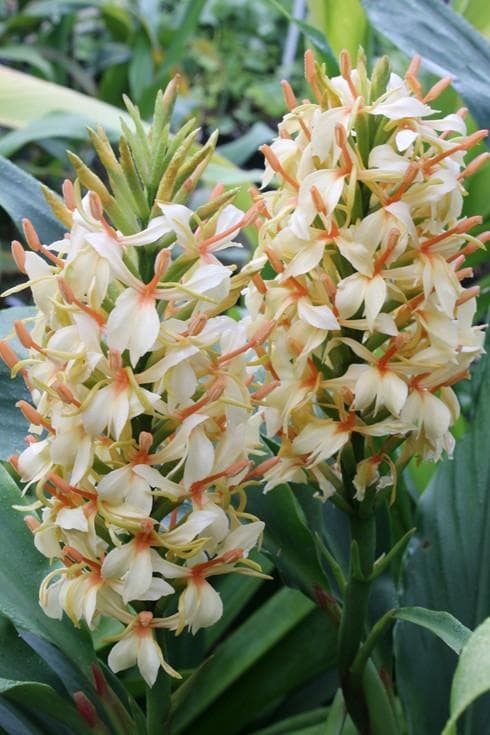Cautleya Spicata Roscoea cautleyoides 'Purple Queen'

ABOUT
The 'Purple Queen' is a striking perennial that boasts a lush clump of long, strap-shaped leaves, which have a vibrant green color. Rising prominently from the foliage are the stunning flowers. The blooms are tubular, resembling orchids, and are characterized by a regal purple hue that is bold and eye-catching. These flowers have a delicate and exotic look with a soft upper petal called a hood and a lip-like lower petal that is often attractively marked. The plant exudes an oriental charm that adds an alluring elegance to any garden setting where it is planted.
About this plant
 Names
NamesFamily
Zingiberaceae
Synonyms
Purple Queen Roscoea, Cautleya-like Roscoea
Common names
Roscoea cautleyoides 'Purple Queen'.
 Toxicity
ToxicityTo humans
The Himalayan ginger is not known to be toxic to humans. No significant toxicity has been associated with this plant, and there are no well-documented cases of poisoning from ingestion of any part of the Himalayan ginger. However, as with all plants, individual allergies or sensitivities can occur so it's always advised to be cautious when handling or ingesting plants not commonly used as food.
To pets
The Himalayan ginger is not known to be toxic to pets. It is not listed as a poisonous plant for animals such as dogs and cats, and there are no prevalent reports of toxicity related to this plant. However, while the Himalayan ginger may not be toxic, ingestion of non-food plants can sometimes cause gastrointestinal upset in pets, so it's wise to keep an eye on pets around any plant.
 Characteristics
CharacteristicsLife cycle
Perennials
Foliage type
Deciduous
Color of leaves
Green
Flower color
Purple
Height
1-2 feet (30-60 cm)
Spread
0.5-1 feet (15-30 cm)
Plant type
Herb
Hardiness zones
6
Native area
Himalayas
Benefits
 General Benefits
General Benefits- Ornamental Value: Adds vivid purple color to gardens with its striking flowers.
- Ease of Care: Generally low-maintenance, requiring minimal care once established.
- Attracts Wildlife: Flowers can attract pollinators such as bees, butterflies, and birds.
- Drought Resistance: Can withstand periods of low water once established, suitable for xeriscapes.
- Cold Hardy: Capable of surviving in cooler climates, offering landscape variety in temperate regions.
- Compact Size: Suitable for smaller gardens or spaces where a smaller plant is desired.
- Unique Bloom: Uncommon flower shape adds an exotic touch to a garden collection.
- Seasonal Interest: Provides late spring to summer interest in garden beds and borders.
 Medical Properties
Medical PropertiesThis plant is not used for medical purposes.
 Air-purifying Qualities
Air-purifying QualitiesThis plant is not specifically known for air purifying qualities.
 Other Uses
Other Uses- Fabric dye: The roots of the Himalayan ginger can be used to produce a natural dye for fabric, giving it a unique and organic color.
- Culinary garnish: The flowers can be used as an attractive edible garnish on salads or desserts to add a splash of color.
- Photography subject: Due to its striking purple blooms, the Himalayan ginger makes an excellent subject for botanical photography.
- Traditional ceremonies: In some cultures, the plant may be incorporated into ceremonial garlands or decorations for its aesthetic appeal.
- Insectary plant: The flowers attract beneficial pollinators like bees and butterflies, supporting biodiversity in the garden.
- Artistic inspiration: Artists may be inspired by the intricate form and color of Himalayan ginger for paintings or textile designs.
- Education: Botanic gardens could use it as an example to teach about plant adaptation in alpine environments due to its origin.
- Crafting: The strong stems can be used in floristry and crafts for creating naturalistic arrangements and decorations.
- Theme gardens: Himalayan ginger can be a focal point in thematic gardens, such as Asian-inspired landscapes or purple color-themed beds.
- Eco-friendly confetti: Dried petals of the plant could serve as biodegradable confetti for outdoor celebrations.
Interesting Facts
 Feng Shui
Feng ShuiThe Roscoea is not used in Feng Shui practice.
 Zodiac Sign Compitability
Zodiac Sign CompitabilityThe Roscoea is not used in astrology practice.
 Plant Symbolism
Plant Symbolism- Rarity and Exclusivity: Roscoea cautleyoides 'Purple Queen', also known as the Hardy Orchid, is not a commonly found plant in gardens. Its presence can symbolize something unique or of special value.
- Beauty and Elegance: With its striking purple flowers, the Hardy Orchid represents beauty and refinement, making it an emblem of aesthetic appreciation.
- Adaptability: As a plant that is resilient and can thrive in various conditions, the Hardy Orchid can be seen as a symbol of adaptability and endurance.
- Mystery: The exotic appearance of the Hardy Orchid often conveys a sense of mystery or something exotic and undiscovered.
 Water
WaterThe Purple Queen Orchid Ginger prefers consistently moist soil, particularly during its active growing season in the spring and summer. Water thoroughly once the top inch of soil begins to feel dry, which typically means watering once a week. Avoid letting the soil completely dry out, and reduce watering frequency during the dormant winter months to prevent waterlogging. Depending on the pot size and environmental conditions, a rough estimation would be about half a gallon of water every week during the active growing period.
 Light
LightPurple Queen Orchid Ginger thrives in partial shade with bright, indirect light. It is best positioned where it can receive morning sunlight and afternoon shade, as intense direct sunlight can scorch the leaves. A spot with dappled sunlight, like under a canopy of trees, would be ideal.
 Temperature
TemperaturePurple Queen Orchid Ginger prefers a moderate temperature range and can usually tolerate temperatures as low as 32 degrees Fahrenheit to as high as 85 degrees Fahrenheit. The ideal temperature for this plant is between 60 and 75 degrees Fahrenheit; deliberate protection is necessary if temperatures are expected to dip below freezing.
 Pruning
PruningPruning of Purple Queen Orchid Ginger is mainly to remove spent flowers and withered leaves, encouraging healthier growth and a tidier appearance. Prune after flowering, typically in late summer or early fall. This plant doesn't require heavy pruning, so limit it to tidying up and cutting back any dead tissue.
 Cleaning
CleaningAs needed
 Soil
SoilHimalayan Ginger 'Purple Queen' prefers a rich, well-draining loam soil with a pH of 6.0-6.5. A mix of garden soil, compost, and perlite or sand will create an ideal environment for healthy growth.
 Repotting
RepottingHimalayan Ginger 'Purple Queen' does not typically need frequent repotting and can be repotted every 2-3 years or when the rhizomes outgrow their container.
 Humidity & Misting
Humidity & MistingHimalayan Ginger 'Purple Queen' thrives at a humidity level of 60-70% but can tolerate lower humidity levels if not exposed to dry air for extended periods.
 Suitable locations
Suitable locationsIndoor
Use bright indirect light and maintain moisture for Himalayan Ginger.
Outdoor
Plant in partial shade; protect from hot sun and harsh winds for Himalayan Ginger.
Hardiness zone
7-9 USDA
 Life cycle
Life cycleThe Roscoea cautleyoides 'Purple Queen', commonly known as Ginger Lily, begins its life cycle as a rhizome, a type of underground stem that stores energy and nutrients. Upon the arrival of warm spring temperatures, new shoots emerge from the rhizome, developing into stems with long, lance-shaped leaves. As the plant matures, usually in late spring to early summer, flower buds form and bloom into distinctive purple flowers that attract pollinators. After pollination, the flowers are followed by seed capsules if the conditions are right, though this plant is more commonly propagated by rhizome division. As autumn approaches, the aboveground foliage dies back, and the plant enters a dormant phase during the colder months. Throughout winter, the rhizome remains dormant underground until the conditions become favorable again for the next growth cycle in spring.
 Propogation
PropogationPropogation time
Spring to early summer
The Roscoea cautleyoides 'Purple Queen', commonly known as the Purple Queen ginger, is typically propagated by division. This is the most popular method as it helps to create new plants that are genetically identical to the parent plant. The best time to propagate this plant is in the spring, as the plant emerges from dormancy. To propagate by division, carefully dig up the entire plant, making sure to keep a good amount of soil around the roots. Gently separate the rhizomes, ensuring that each division has at least one growth bud. Replant the divisions promptly, placing them at the same depth they were growing previously. It is important to water the newly planted divisions well, providing them with an inch (about 2.5 centimeters) of water per week, to help them establish in their new location.
